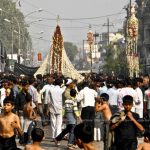Lucknow Ki Galiya’n
Streets which are rich in history & traditions…!
The moonlit lanes of chowk and soothing sound echoing in background on radio “Jane kitne dino ke baad, gali me aaj chand nikla”, takes you back to an era when Lucknow was known for its narrow lanes and parks spread uniquely and uniformly over the areas of Chowk, Nakhas and what not we call in dates as purana Lucknow.
One will not be wrong if believes that art and culture flourish in each and every corner of the city. The alleys can be said to be soaked in with numerous art forms, literature, cultural beauty and stories from the past. These alleyways have not only witnessed numerous historic events but also have played a very crucial role in lives of many eminent personalities like the legendry poet Nirala, Premchand, Sampurnand, Acharya Narendra Dev, Qurratul ain Haider, Sunil Dutt and Amritlal Nagar who have spent a major part of their life in these alleys, reciting poetries, which can easily be seen in their respective works depicting their love for the city.
From team Observer, Arif takes up the responsibility to be the guide of the day to show up these alleys to the new generation who are completely unaware of the golden past of the beautiful city alleyways.
Among the most ancient of the cities of the world like Rome, London, Paris, Cairo, Damascus, Delhi, Agra, Banaras, Jaipur, Mathura etc, the beauty of the roads, lanes and alleys is remarkable. Their intricate net entraps the entire cities and the temptation of their majesty is effective even to this day. When an inspired youth may take keen interest in these alleys, somewhere, in the lost corner of his heart, a thought might resound- “Jaane kitne dino ke baad, gali me aaj chand nikala”.
Streets Known By Their Names
Lucknow has its own world of streets n alleys which are famous for work done in them or for any other identity. For instance streets based on caste names like Gujrati gali, Marwadi wali gali, Singhan ki gali, Kaysthon ki gali, Sunaron ki gali, Babbu wali gali, gali Narayan das etc whereas others are named after the business which are spread over them like Meenas wali gali, Baan wali gali, Kanghi wali gali, Phool wali gali, Churi wali gali, Batashe wali gali, gali Hammam, Taar wali gali, Laiya wali gali, Chik wali gali, Patthar wali gali, Sirke wali gali, Taape wali gali, Sheermal wali gali, Dari wali gali, Joote wali gali, Janaab ki gali, Peepal wali gali, Chaawal wali gali, Parche wali gali, Maide wali gali, Gali meet mata, Kaale ki gali, Bhainse wali gali, Gadhe wali gali and Achhuti gali are the most famous ones.
Golden Past Of The Alleys
Master Amritlal Nagar used to call these alleys as ‘Binoculars of Lucknow’. Revering Chowk’s Baan Wali Gali as his workplace, Mr. Nagar used his Brother Madanlal Nagar’s painting for the cover of his novel Shatranj Ke Mohre, in 1957, in which Lucknow’s alleys were distinctly portrayed. The Khinni Wali Gali had Mir Taqi Mir’s Daulatkhana. Peenas wali Gali has Maulwi Anwar Bagh abutted to it, where Hazrat Mohani Sahab was cremated. Taksaal Wali Gali is at Hiran Park Chauraha, where Hazrat Nasikh was buried. Mirza Dabeer was buried at Kucha- e-Dabeer, whereas the king of Mersiah, Mir Anees was buried at Kucha-e-Mir Anees. The master of music, Naushad resided in the alleys of Darsani Peer.
Mesmerising Lanes, Triumph Literature
Even the masterpiece like “Aag ka Dariya” and “Chandni” by Qurratul ain Haider which were even awarded Jnanpith award were written in these alleyways of Chowk. Senior journalist, Late Ramkrishna used to narrate the stories of Nirala who used to reside in Batashe wali gali in Aminabad. A number of masterpieces were composed by Nirala, while he lived here which were later on published by Ganga Granthagar, owned by Dulare Lal Bhargav. During the phase of pre Independence, whenever Motilal Nehru visited Lucknow, he too used to recluse In Batashe wali gali whereas Premchand resided in Marwari gali. He even wrote Rangbhumi while he occupied a tiny quarter in Ramtirth’s abode. In 1937 Babu Sampurnanand used to reside in the same residence which was later on occupied by Acharya Narendra Dev. In 1942, the August Movement was co-ordinated from the very same alley due to the reason that the alleyways opened on three sides, which provided the facilities to the protesters to vanish in thin air, at the first sign of danger. The leader of the movement, Keshavdev Malviya too lived here. Lal Bahadur Shastri also visited the alley frequently, whereas Gannewali gali is home to Balraj Dutt famously known as Sunil Dutt. Even after he shifted to Mumbai, he always ventured to this place, whenever he visited Lucknow. The fame of Gannewali gali was increased manifold when Sanjay Dutt paid homage to his father’s old asylum.
Baanwali Gali Ki Kahani Khud Amritlal Nagar Ki Zubani
The alley in Chowk, which is in times is known as Baanwali gali, once used to be famous as Vaidon wali gali. Many of vaidya (physician) were highly renowned among the people across the city. It was discovered in 1698 that in 1620 Vaidya Maniram ji Saraswat Jaitley wrote ‘Gunratnamala’, a book of medicine, which was later on published in 1886 by Maniram’s descendent Kalluji Vaidya. In the final chapter of his book, for the purpose of an introduction to his bloodline he travelled through the city and across Gomti, and created the best of his verses; Looking at them, it is not hard to believe that the language must have possessed some poet of superlative degree, who were lost in anonymity due to the unfortunate absence of relative description. Chaupatiyan resident, Late Radhe Narayaji Vajpeyi, ‘Prajavaidya’ had maintained not only a catalogue of the city’s ancient writers but also a collection of some of their masterpieces in his notebook. After his demise, that notebook was destroyed due to the carelessness of his family members. I was once told by Late revered Pandit Roopnarayanji that after Prajavaidya’s death, he approached the family himself and asked for the notebook but the family cited that the notebook was precious, thus they did not allow Panditji even to have a glimpse of it. After Prajavaidya, only Late Lala Ramnarayan Swarnkar had a little knowledge about ancient artifacts, but he too, could not pen down that knowledge into a scripted record. In this fashion, the ancient poetic literature and history of Lucknow was lost forever.
Arif
Writer is journalist by profession and deeply interested in the subject Lucknow




